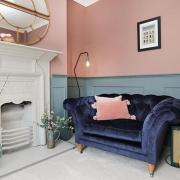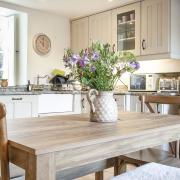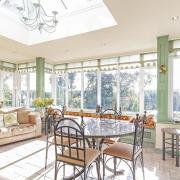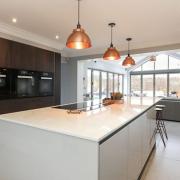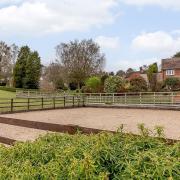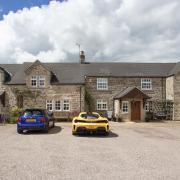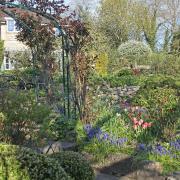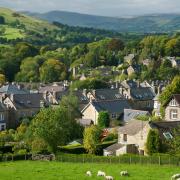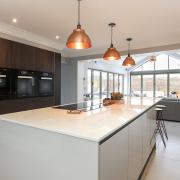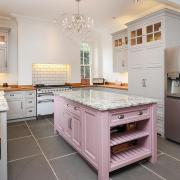The rotating home being built on the outskirts of Ashbourne.
Robin Hamilton is planning a revolution. In order to finance his plans he is even prepared to sell his 19-acre country estate, which is set in beautiful rolling countryside south of Ashbourne. If the sale of his farmhouse and its many outbuildings goes ahead, he and his wife Rosy, who is a willing accomplice, will move 100 yards downhill and take up residence in a secluded hollow, where he is constructing a new house called The Dumble. It is here that the revolution will begin.Robin's mission is to overthrow traditional notions of construction and drive a revolution in building design by using The Dumble as a vehicle for his ideas. Although the Hamiltons will be vacating their superbly sited hill-top farmhouse, they will have the compensation of living in a new home that will have the remarkable ability to rotate on its axis and provide them with ever-changing views across the Dove Valley to the Weaver Hills. When completed, The Dumble will be the largest rotating private house in the world and a truly revolutionary structure.In fact, the changing vistas will be no more than a fortunate spin-off, so to speak, of a mechanism designed to capture and store renewable energy. By rotating through 180 degrees over a 12 hour period, The Dumble will follow the sun from dawn until dusk, tapping maximum amounts of solar energy along the way. A discrete turbine system located within the roof will harness wind energy and an underground 'aquifier' will supply all the building's water requirements, with ground-source heat pumps and heat exchangers combining to provide hot water, heating and energy storage.It was Le Corbusier, the great Swiss architect, who suggested that a house should be regarded as a 'machine fit to live in', but it is Robin Hamilton who has made this concept real by designing a zero-energy machine that will double as a very desirable home. Significantly, Robin is not an architect, but a multi-disciplinary engineer with over 40 years' experience in the aeronautical, automotive, recycling and renewable energy industries.After leaving Rugby Engineering College, Robin became a staff engineer at Rolls-Royce, where he worked on advanced aero engines. However, in his spare time he began buying and selling cars, particularly sports cars, and became the proud owner of an Aston Martin. His hobby became a full-time occupation in 1971, when he left Rolls-Royce to set up his own company, which became a main distributorship for Aston Martin. He even developed a competition division that was responsible for taking Aston Martin back to Le Mans in the late 1970s, with himself, no less, as a driver. The company went on to produce the Nimrod series of cars, which competed in the World Sports Car Championships in the 1980s, gaining third place in their very first year of competition.Many mementoes of Robin's racing days line the walls and shelves of his office in one of the outbuildings at his farm, but there is an incongruous presence alongside the many photographs and models of sleek racing cars. On one wall, there is a small picture of a stubby, window-less vehicle that almost looks as if it could have extra-terrestrial origins, a suspicion seemingly reinforced by its name of 'ET2'.Explaining the true origin of this little machine and its right to be placed alongside his beloved Astons, Robin said: 'One windy day, I was sitting in London's Green Park. An attendant was raking up leaves and collecting them in a dust sheet, only to find that they were being scattered again by the wind. As I walked away, I noticed that the leaves which had been blown away were also swirling in neat eddies. It occurred to me that it might be possible to collect leaves and litter by using a machine that imitated this natural process. What's more, a collection method based on air-flow, rather than suction, would leave the surface undisturbed.'Prompted by this observation, Robin built several ET2 prototypes (Environmental Tidying using Enterprising Technology) before marketing his innovation. Not content with merely devising a means of picking up litter and rubbish, he developed the technology so that the waste could be shredded and compacted to one sixtieth of its original size. This led to the introduction of new waste-handling machinery that soon found its way into hotels, breweries, dairies and even cruise liners.Having also developed an effective means of turning waste into energy, Robin became more and more aware of environmental issues and began to apply his highly creative mind to the possibility of making buildings much more energy-efficient. He said, 'Realising that most buildings are far too inert and do little to harness renewable energy, I wondered if there might be a better way of constructing them.'It occurred to Robin that the mechanics of rotation, which he had used so effectively in previous activities, could be used to create buildings that could harness solar energy by rotating with the sun as it moves across the sky. After six years of planning, he was ready to put his ideas into practice. When a former quarry on the edge of his estate became available, the inventor saw his chance. This large depression in the ground, or 'dumble', would become the site of his revolutionary building.Robin then set about convincing the planners that they should give consent under National Planning Policy Statement 7, which states, 'Very occasionally, the exceptional quality and innovative nature of the design of a proposed, isolated new house may provide special justification for granting planning permission.' It didn't take long for the planners at Derbyshire Dales District Council to realise that Robin's rotating house would fit this description. With its sunken location and sedum roof, it would be deferential to the landscape. The hollow site would be shaped to funnel in enough wind to drive a turbine and the building would even have the ability to swing away from the sun on particularly hot days. It would also have the capacity to store energy, providing cooling in warm weather and heating in cold weather.With planning consent in place by January 2007, Robin knew that he would need to raise funds by selling his farmhouse. Aware that he and Rosy would have to live somewhere during the building process, he decided that the first phase of construction would be a curved wing adjacent to, but not quite touching, The Dumble. This annexe would have garages on the ground floor and living space on the upper floor, which he and Rosy could use as temporary accommodation.At the time of my visit, the farmhouse was on the market, the circular base of The Dumble was in place, the bore hole for the well and the heat pump had been dug and the curved wing was nearing completion. Even this non-rotating section has a glut of innovative features, including insulated walls made of giant re-cycled plastic pipes, which are set vertically and filled with concrete to provide thermal mass. Robin has also developed a new environmentally friendly form of concrete. Christened 'Dumblecrete', it uses absolutely no cement. Robin and Rosy plan to move into the rotating section of the house when construction is complete but, just in case the sale of the farmhouse doesn't go ahead or the finances don't add up, Robin has put The Dumble on the market at a guide price of �4.5 million. Potential buyers are promised an amazing house of outstanding contemporary design, because Robin and his architect, Ian Bevan, have been determined not to create an 'eco-freak'. 'Wow' factors will include a stunning central spiral stairway and a huge curved balcony that is partly protected by the roof overhang. The notional design has bedrooms on the ground floor, living accommodation on the second floor and an open-plan leisure-cum-gallery space on the top floor. However, as there are no internal load-bearing walls, the house can be configured to any requirement. Whether or not Robin ends up living in The Dumble, which he is naturally keen to do, he is determined to complete the building. It comes as no surprise to learn that his project is being filmed for possible broadcast next year in Kevin McCloud's Channel 4 Grand Designs series. Derbyshire Life will also be following this exciting project through to its conclusion. Next year, I'll be returning to The Dumble in the hope that I'll be offered a spin in the revolutionary house.
The Dumble is on the market at �4.5 million through Knight Frank or Fisher German.





